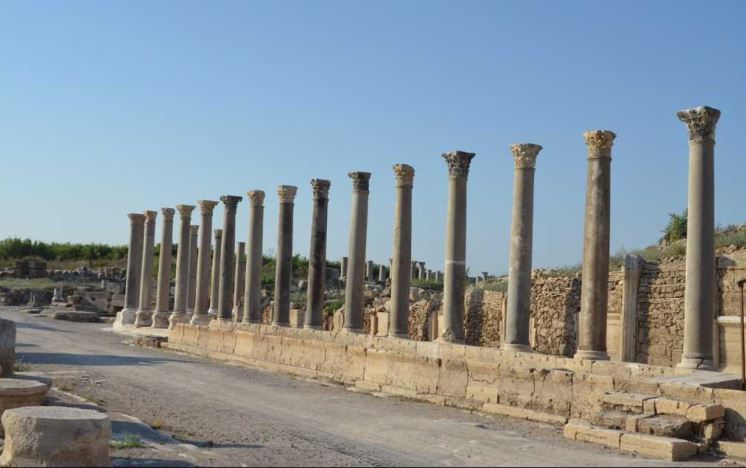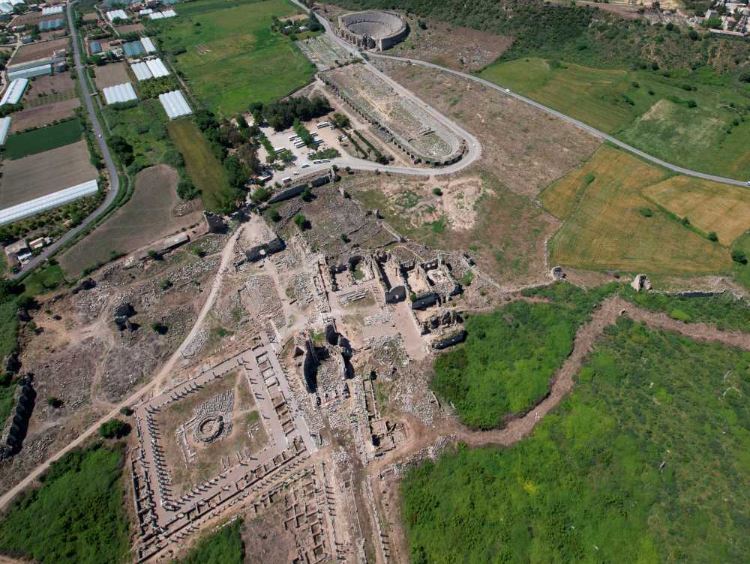
Discovering Perge: An Ancient City in Antalya
Perge Ancient City is located in Antalya, Turkey, and is known for its remarkable archaeological significance and well-preserved ruins. It stands as one of the most important ancient sites in the region, reflecting the grandeur of its historical past. This ancient city attracts tourists and history enthusiasts from around the globe, offering them a chance to walk through its storied streets and marvel at its architectural achievements. Perge was once a bustling city in the ancient region of Pamphylia, and its ruins provide a fascinating glimpse into Roman life.
Table of Contents
Perge Ancient City Location
Perge Ancient City is situated about 17 kilometers east of Antalya’s city center, in the Aksu district. This proximity to Antalya makes it easily accessible for visitors staying in the city or nearby resorts. The site lies in a lush, fertile plain surrounded by the scenic beauty of the Turkish landscape. The location was strategically chosen by its ancient founders due to its access to the Aksu River, which facilitated trade and communication.

How to Get to Perge
Traveling to Perge is straightforward, with several transportation options available. Visitors can drive, take a bus, or join a guided tour from Antalya or other nearby regions. The drive from Antalya to Perge takes approximately 20 minutes, making it a convenient day trip for those staying in the city.
- By Car: Renting a car gives you the flexibility to explore at your own pace. The route from Antalya to Perge is well-signposted and easy to navigate.
- By Bus: Regular buses operate from Antalya’s city center to Aksu, where Perge is located. From the bus stop, it is a short walk to the archaeological site.
- Guided Tours: Many tour operators in Antalya offer guided tours to Perge, often combined with visits to nearby attractions like Aspendos and Side.
Highlights of Perge
Perge offers a wealth of attractions that showcase its historical and cultural significance. The ruins are extensive, providing a comprehensive view of ancient urban planning and architecture. Key highlights include:
- The Roman Theater: This impressive theater could seat up to 15,000 people and was used for plays, concerts, and public gatherings. It is one of the best-preserved structures in Perge and offers a glimpse into the cultural life of the city.
- The Stadium: The stadium is another remarkable structure, with a capacity of around 12,000 spectators. It hosted athletic competitions and served as a venue for various public events.
- The Hellenistic Gate: This grand entrance to the city features two round towers and a well-preserved archway. It served as both a defensive structure and a symbol of the city’s strength and prosperity.
- The Agora: The agora was the commercial heart of Perge, bustling with merchants and traders. It was a central marketplace where goods from across the region were bought and sold.
- The Nymphaeum: This monumental fountain was dedicated to the nymphs and provided water for the city. It is an example of the sophisticated water management systems used by the ancients.
Why Visit Perge Ancient City?
Visiting Perge is like taking a step back in time. The site offers a unique glimpse into the daily life and culture of a once-thriving city. The ruins are remarkably well-preserved, allowing visitors to imagine what life was like during the Roman period.
- Historical Significance: Perge was a major city in the ancient region of Pamphylia and played a crucial role in the spread of Christianity. The Apostle Paul visited Perge during his missionary journeys, adding to its historical importance.
- Architectural Marvel: The city’s architecture reflects the grandeur and sophistication of Roman engineering. From the colonnaded streets to the intricate mosaics, Perge showcases the artistic and architectural achievements of its time.
- Cultural Insights: Exploring Perge provides valuable insights into the cultural, social, and economic life of its inhabitants. Visitors can learn about the city’s role as a trade hub and its contributions to art and culture.
Perge Ancient City Legends and History
Perge’s history is rich with legends and historical tales. According to ancient sources, the city was founded by Greek settlers after the Trojan War. It flourished during the Hellenistic period and later became an important center under Roman rule. The city’s strategic location and fertile lands contributed to its prosperity.
Perge was also an early center of Christianity. The Apostle Paul visited the city, as mentioned in the Acts of the Apostles. This visit helped establish Perge as a significant site in the early Christian world. The city’s decline began in the Byzantine period, as shifting trade routes and repeated invasions took their toll.
Interesting Facts About Perge
- Ancient City: Perge was one of the most important cities in ancient Pamphylia, known for its wealth and cultural influence.
- St. Paul: The Apostle Paul’s visit to Perge is documented in the New Testament, highlighting the city’s early Christian significance.
- Water Channels: The city had advanced water channels and aqueducts that supplied fresh water, demonstrating sophisticated engineering skills.
- Mosaic Floors: Many buildings in Perge feature intricate mosaic floors, showcasing the artistic talents of its inhabitants.
Architecture and Design of Perge Ancient City
Perge’s architecture reflects the city’s historical development and cultural influences. The town is characterized by its well-planned streets and impressive public buildings. Notable architectural features include:
- Colonnaded Streets: The main street of Perge is lined with columns and shops, providing a glimpse into the daily life of its residents. The street was designed to facilitate trade and transportation.
- Bath Complex: The Roman baths were an essential part of social life in Perge. They were used for relaxation, socializing, and conducting business.
- Towers and Walls: The city’s defensive walls and towers were designed to protect against invasions. They are a testament to the strategic importance of Perge.
- Nymphaeum: This ornamental fountain was both a practical and decorative feature, supplying water and serving as a gathering place.
Perge Ancient City Nearby Attractions
Perge’s location in Antalya makes it a convenient base for exploring other attractions in the region. Some nearby sites worth visiting include:
- Aspendos: This ancient city is famous for its well-preserved Roman theater, which is still used for performances today.
- Antalya City: The city of Antalya offers a blend of modern amenities and historical sites, including the Old Town (Kaleiçi), Hadrian’s Gate, and the Antalya Museum.
- Düden Waterfalls: These beautiful waterfalls are a short drive from Perge, offering a refreshing natural escape.
- Side: Another ancient city, Side is known for its Roman ruins and picturesque harbor.
Best Time to Visit
The best time to visit Perge is during the spring (April to June) and autumn (September to November). During these months, the weather is mild and pleasant, making it ideal for exploring the open-air site. Summer can be extremely hot, while winter may bring rain and cooler temperatures.
Dress Code
While there is no strict dress code for visiting Perge, it is advisable to dress comfortably and appropriately for outdoor exploration. Consider the following:
- Comfortable Shoes: The site involves a lot of walking, so sturdy footwear is essential.
- Sun Protection: Hats, sunglasses, and sunscreen are recommended, especially during the warmer months.
- Light Clothing: Wear light, breathable clothing to stay comfortable in the heat.
Opening Hours
I think it’s best to check the schedule in advance, since
Entrance Fees
There is an entrance fee to visit Perge, which is quite reasonable considering the size and significance of the site. The fee includes access to the entire archaeological area, including the theater, stadium, and other major attractions. Discounts may be available for children, students, and seniors.
Museum Pass: Valid or Not
The Museum Pass Turkey is valid for entry to Perge. This pass allows unlimited access to many museums and archaeological sites across Turkey, making it a cost-effective option for those planning to visit multiple locations. The pass can be purchased online or at participating sites.
Tips for Visitors
To make the most of your visit to Perge, consider the following tips:
- Arrive Early: Visiting early in the day can help you avoid crowds and enjoy the site in a more relaxed atmosphere.
- Bring Water: Staying hydrated is important, especially on hot days. There are limited facilities on-site, so it would be best to bring your water.
- Take Photos: The ruins and surrounding landscapes offer excellent photo opportunities. Capture the beauty and history of Perge with your camera.
- Use a Guidebook: A guidebook or map can enhance your visit by providing additional information about the site’s history and significance.
- Respect the Site: Do not climb on the ruins or remove artifacts. Preserving the integrity of the site ensures that future generations can also enjoy its wonders.
In conclusion, Perge is a remarkable ancient city that offers a fascinating journey through history. With its well-preserved ruins and rich cultural heritage, it is a must-visit destination for history enthusiasts and travelers alike. Whether you are interested in exploring ancient architecture, learning about the city’s past, or simply enjoying the scenic beauty of the region, Perge has something for everyone.
FAQ
- How do I get to Perge from Antalya?
You can drive, take a bus, or join a guided tour from Antalya to Perge. The journey takes about 20 minutes by car.
- What is the best time to visit Perge?
The best time to visit is in spring (April to June) or autumn (September to November) when the weather is mild.
- Is there an entrance fee for Perge?
Yes, there is an entrance fee to access the site, with discounts available for children, students, and seniors.
- Do you know if I can Can I use the Museum Pass Turkey at Perge?
Yes, the Museum Pass is valid for entry to Perge and allows access to many other sites in Turkey.
- Are guided tours available at Perge?
Yes, guided tours are available and can enhance your visit by providing valuable insights into the history and significance of the site.



